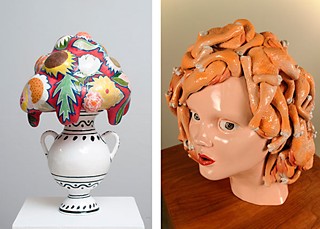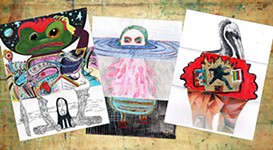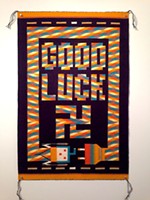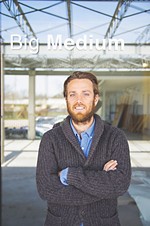"Julie Moon and Rick Mansfield: Green Zone"
Julie Moon and Rick Mansfield are both sculptors, but their work here comes from opposite ends of the sculpting spectrum
Reviewed by Caitlin Greenwood, Fri., Dec. 5, 2014
"Julie Moon and Rick Mansfield: Green Zone"
MASS Gallery, 507 Calles #108www.massgallery.org
Through Dec. 13
Julie Moon and Rick Mansfield are featured together in MASS Gallery's "Green Zone" exhibition, which is loosely a study in remaking the lifeless objects that decorate our more intimate spaces, but the two artists might exist at opposite ends of the sculpting spectrum.
Moon, a Canadian ceramicist working out of Toronto, focuses on the abstract and colorful. Her large-scale ceramic plants – some of which you may recognize and others that look to be of the artist's invention – make the gallery space pop. Beautiful artichoke flowers in a black candelabrum sit aside a vase of multicolored, patchwork-pattern palm fronds. Moon's sculptures, while beautiful in their form, are notable for the artist's expert glazing hand. The colors and details make Moon's pieces memorable and bring the inanimate to life.
Rick Mansfield, an Austin resident and MASS member, takes a wildly different approach to his work – emphasis on the wild. Working in cast and painted bronze, Mansfield takes pop-culture imagery and pushes it in bizarre and playful new directions. A girl with chicken legs for hair (which can best be described as Col. Sanders' interpretation of Medusa) coyly peers across the gallery. A ferocious dog dramatically snarls with a boy jutting out of his head. A man with a golden crown has a turkey, complete with a jaunty gentleman rider, for a face. Mansfield's wackiness almost overwhelms the strength of the pieces. Bronze is no easy undertaking, and Mansfield is an expert metalworker. However, his subjects are so distracting that it's difficult to acutely focus on his sculptural talent.
Moon and Mansfield are challenging artists with extremely different perspectives. That chasm in vision unfortunately undermines the show's cohesion. "Green Zone" showcases the advances in contemporary sculpture but lacks the focus to bring new understanding to the topic of decorative work.













